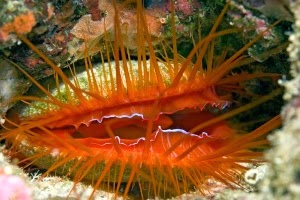Though fascinating,
this flamboyant bivalve (Ctenoides ales) is still poorly understood, something Lindsey
Dougherty, a graduate student at the University of California, Berkeley is
trying to change.
Earlier this year, Ms Dougherty shed light on how the clam's flashing works—by reflecting light through tiny bits of silica near the edge of its shell and not through bioluminescence like other species.
Now Ms Dougherty and her
colleagues have gotten closer to why the clams put on their marine light show:
to warn predators or lure prey.
"Most animals
don't do something that's energetically costly unless there's [a payoff],"
said Ms Dougherty, who presented the new research this week at the annual
conference of the Society of Integrative and Comparative Biology in West Palm
Beach, Florida, USA.
For instance,
"light displays are often used to try to attract a mate or to attract
prey, and some of the displays can also be defensive, like with the [extremely
poisonous] blue-ringed octopus," she said.
Ms Dougherty and her
team tested three hypotheses for the clam's brilliance: attracting a mate to
spawn eggs, catching the attention of light-seeking plankton, or sending a
warning to potential predators.
The scientists tested
the three hypotheses by introducing threats, food, and the opposite sex into
tanks with captive clams and observing how the molluscs reacted.
The team found little
evidence that the disco flashing draws in suitors, since the clams' eyesight is
likely too poor to see the flashes.
But the other two
hypotheses bore (at least preliminary) fruit.
When the team moved a
fake predator toward a disco clam, its flash increased in frequency, from 1.5
to 2.5 hertz, she said.
"So it has a really obvious reaction to potential predators."
"So it has a really obvious reaction to potential predators."
When plankton were
introduced to the tank, the disco clams flash rate also increased, although not
as much.
In both instances,
"... they get excited, you could say. Excited or scared."
The team was
surprised to find sulphur in both the tentacles and mantle—the fleshy
protruding part—of the disco clam.
"Sulphur is the
main ingredient in sulphuric acid, which is really distasteful to
predators," Ms Dougherty said.
To further test the
predator hypothesis, the team introduced the mantis shrimp, a type of
aggressive crustacean, into the tank.
The shrimp then
started acting strangely, "We have some footage of a mantis shrimp sort of
recoiling and then cleaning its mouth parts and then going into a catatonic
state after interacting with the disco."
Ms Dougherty says that
suggests that the predator ignored the clam's flashing only to taste something
it didn't like, like sulphuric acid.
She added that more
research is necessary in the wild to determine whether plankton can actually
see the disco's visual displays, and whether similar types of clams also
secrete sulphuric acid.
That's no problem for
Ms Dougherty. "For me,"
she said, "the most fun place is underwater with the clams."
Read the article and watch the video HERE.
Read the article and watch the video HERE.
The Aquaculturists
This blog is maintained by The Aquaculturists staff and is supported by the
magazine International Aquafeed which is published by Perendale Publishers Ltd
magazine International Aquafeed which is published by Perendale Publishers Ltd
For additional daily news from aquaculture around the world: aquaculture-news


No comments:
Post a Comment